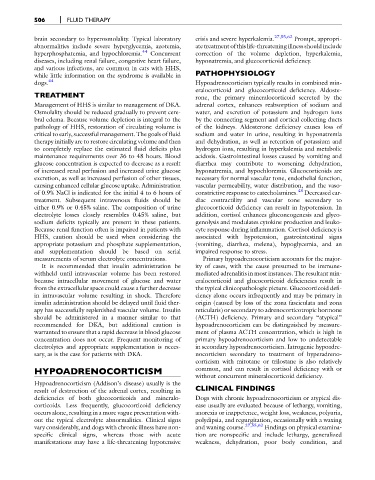Page 518 - Fluid, Electrolyte, and Acid-Base Disorders in Small Animal Practice
P. 518
506 FLUID THERAPY
brain secondary to hyperosmolality. Typical laboratory crisis and severe hyperkalemia. 27,55,62 Prompt, appropri-
abnormalities include severe hyperglycemia, azotemia, ate treatment of this life-threatening illness should include
hyperphosphatemia, and hypochloremia. 44 Concurrent correction of the volume depletion, hyperkalemia,
diseases, including renal failure, congestive heart failure, hyponatremia, and glucocorticoid deficiency.
and various infections, are common in cats with HHS,
while little information on the syndrome is available in PATHOPHYSIOLOGY
dogs. 44 Hypoadrenocorticism typically results in combined min-
eralocorticoid and glucocorticoid deficiency. Aldoste-
TREATMENT rone, the primary mineralocorticoid secreted by the
Management of HHS is similar to management of DKA. adrenal cortex, enhances reabsorption of sodium and
Osmolality should be reduced gradually to prevent cere- water, and excretion of potassium and hydrogen ions
bral edema. Because volume depletion is integral to the by the connecting segment and cortical collecting ducts
pathology of HHS, restoration of circulating volume is of the kidneys. Aldosterone deficiency causes loss of
critical to early, successful management. The goals of fluid sodium and water in urine, resulting in hyponatremia
therapy initially are to restore circulating volume and then and dehydration, as well as retention of potassium and
to completely replace the estimated fluid deficits plus hydrogen ions, resulting in hyperkalemia and metabolic
maintenance requirements over 36 to 48 hours. Blood acidosis. Gastrointestinal losses caused by vomiting and
glucose concentration is expected to decrease as a result diarrhea may contribute to worsening dehydration,
of increased renal perfusion and increased urine glucose hyponatremia, and hypochloremia. Glucocorticoids are
excretion, as well as increased perfusion of other tissues, necessary for normal vascular tone, endothelial function,
causing enhanced cellular glucose uptake. Administration vascular permeability, water distribution, and the vaso-
of 0.9% NaCl is indicated for the initial 4 to 6 hours of constrictive response to catecholamines. 48 Decreased car-
treatment. Subsequent intravenous fluids should be diac contractility and vascular tone secondary to
either 0.9% or 0.45% saline. The composition of urine glucocorticoid deficiency can result in hypotension. In
electrolyte losses closely resembles 0.45% saline, but addition, cortisol enhances gluconeogenesis and glyco-
sodium deficits typically are present in these patients. genolysis and modulates cytokine production and leuko-
Because renal function often is impaired in patients with cyte response during inflammation. Cortisol deficiency is
HHS, caution should be used when considering the associated with hypotension, gastrointestinal signs
appropriate potassium and phosphate supplementation, (vomiting, diarrhea, melena), hypoglycemia, and an
and supplementation should be based on serial impaired response to stress.
measurements of serum electrolyte concentrations. Primary hypoadrenocorticism accounts for the major-
It is recommended that insulin administration be ity of cases, with the cause presumed to be immune-
withheld until intravascular volume has been restored mediated adrenalitis in most instances. The resultant min-
because intracellular movement of glucose and water eralocorticoid and glucocorticoid deficiencies result in
from the extracellular space could cause a further decrease the typical clinicopathologic picture. Glucocorticoid defi-
in intravascular volume resulting in shock. Therefore ciency alone occurs infrequently and may be primary in
insulin administration should be delayed until fluid ther- origin (caused by loss of the zona fasciculata and zona
apy has successfully replenished vascular volume. Insulin reticularis) or secondary to adrenocorticotropic hormone
should be administered in a manner similar to that (ACTH) deficiency. Primary and secondary “atypical”
recommended for DKA, but additional caution is hypoadrenocorticism can be distinguished by measure-
warranted to ensure that a rapid decrease in blood glucose ment of plasma ACTH concentration, which is high in
concentration does not occur. Frequent monitoring of primary hypoadrenocorticism and low to undetectable
electrolytes and appropriate supplementation is neces- in secondary hypoadrenocorticism. Iatrogenic hypoadre-
sary, as is the case for patients with DKA. nocorticism secondary to treatment of hyperadreno-
corticism with mitotane or trilostane is also relatively
HYPOADRENOCORTICISM common, and can result in cortisol deficiency with or
without concurrent mineralocorticoid deficiency.
Hypoadrenocorticism (Addison’s disease) usually is the
result of destruction of the adrenal cortex, resulting in CLINICAL FINDINGS
deficiencies of both glucocorticoids and mineralo- Dogs with chronic hypoadrenocorticism or atypical dis-
corticoids. Less frequently, glucocorticoid deficiency ease usually are evaluated because of lethargy, vomiting,
occurs alone, resulting in a more vague presentation with- anorexia or inappetence, weight loss, weakness, polyuria,
out the typical electrolyte abnormalities. Clinical signs polydipsia, and regurgitation, occasionally with a waxing
vary considerably, and dogs with chronic illness have non- and waning course. 27,55,62 Findings on physical examina-
specific clinical signs, whereas those with acute tion are nonspecific and include lethargy, generalized
manifestations may have a life-threatening hypotensive weakness, dehydration, poor body condition, and

